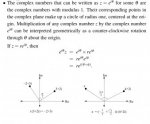I have so many questions about this passage...(attached img)
”Multiplication of any complex number z by the complex number e^iθ can be interpreted geometrically as a counter-clockwise rotation through θ about the origin.” What does it mean to rotate “through” theta. Why can it be interpreted this way?
The second diagram has me confused also; the way it is written makes it look, at least to me, that the positional vector z is multiplied with the other complex number (4+2i) to give z. But isn’t z equal to (-1/2) + ((3^(1^2))/2)?
Please, if someone can explain this I would be tremendously greatful.
”Multiplication of any complex number z by the complex number e^iθ can be interpreted geometrically as a counter-clockwise rotation through θ about the origin.” What does it mean to rotate “through” theta. Why can it be interpreted this way?
The second diagram has me confused also; the way it is written makes it look, at least to me, that the positional vector z is multiplied with the other complex number (4+2i) to give z. But isn’t z equal to (-1/2) + ((3^(1^2))/2)?
Please, if someone can explain this I would be tremendously greatful.

